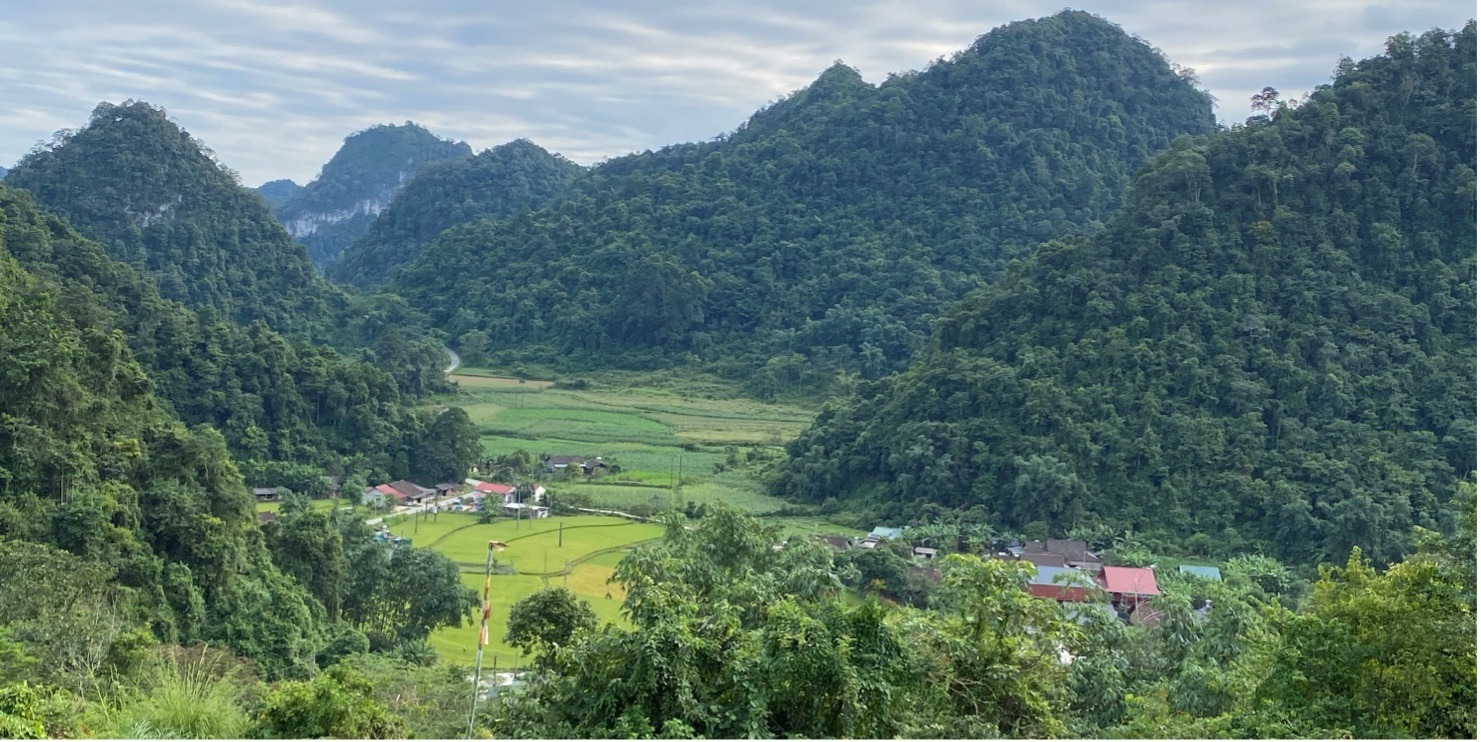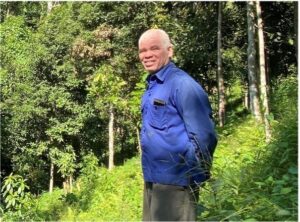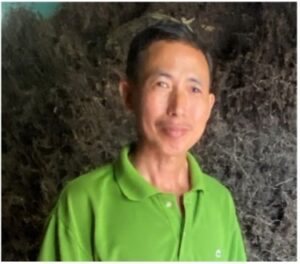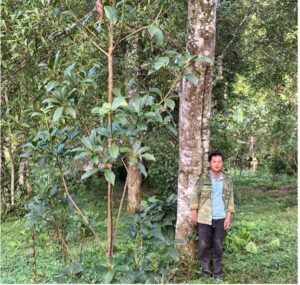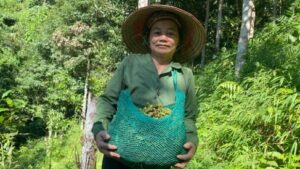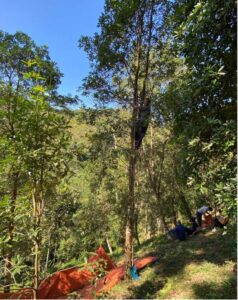1. INTRODUCTION
This case study is one in a series exploring how biotrade (often taken to be the trade in products certified as organic) can become aligned with the principles of BioTrade as elaborated by UNCTAD. UNCTAD defines BioTrade as being when a product or service sourced from biodiversity is commercialized and traded in a way that respects people and nature. The first four of the seven BioTrade principles are explored here in the context of Cao Bang Province, Northern Vietnam. The study was conducted on behalf of the Swiss Secretarial for Economic Affairs (SECO) Regional Biotrade Project phase II (RBTII); the collaborating companies in this case are the Vietnam based Developing Agriculture and Consulting Environment Co., Ltd, DACE and Germany-based Cha-Do.
Published 2023. Authors:
Dr. Jane Carter
Senior Adviser Natural
Resource Governance,
Helvetas Switzerland
Mrs. Dieu Chi Nguyen
Deputy Manager
Regional Biotrade Project
Helvetas Myanmar
Mr. Bui Khanh Tung
Senior Project officer Value Chains
Regional Biotrade Project
CRED
This case study follows from an earlier one[i] conducted on the production of Vietnamese cinnamon (Cinnamomum cassia) in Yen Bai and Lao Cai provinces. That study raised concerns about cinnamon plantations having become a monoculture and provided suggestions on ways to improve biodiversity in future. The landscapes of Cao Bang provide a different example, in that they are more diverse. We begin with a table summarizing how the first four BioTrade principles are being addressed within the landscapes of Cao Bang, focusing on Thach An district. Here the production of cinnamon and star anise (Illicium verum) on steeply sloping hillsides forms an integral part of rural livelihoods along with lowland crop cultivation and animal husbandry.
The first four BioTrade principles of UNCTAD: How the RBTII Project and its partners seek to promote biodiverse landscapes in Cao Bang Province
| 1. Conservation of biodiversity | Both cinnamon and star anise are indigenous to the area, but their active cultivation is only reported to date back some three generations at most. Of particular interest in Cao Bang is the existance of a type of cinnamon known to farmers as small or narrow-leaved cinnamon, which RBTII is seeking to conserve. It has specific properties that distinguish it from the Cinnamonum cassia plantations of Yen Bai and elsewhere. Star anise is cultivated at wide spacing and has a life expectancy of at least 100 years, meaning other species can readily grow around it in a mixed (albeit human-manipulated) forest. |
| 2. Sustainable use of biodiversity | The two companies collaborating with RBTII in Cao Bang only engage with organic producers. This is a default situation in the areas planted with cinnamon and star anise, as farmers use no herbicides, pesticides or fertilizers anyway. Their use of agro-chemicals on lowland fields is also minimal due to the presence of livestock, whose dung is used for fertilizer. Harvesting of star anise does no damage to the trees; in the case of cinnamon, trees are harvested sporadically rather than clear felled. |
| 3. Fair and equitable sharing of benefits | The Vietnamese company DACE and its partner international company Cha-Do has committed to purchasing cinnamon and star anise from Cao Bang at a premium price. The intervention began with organic certification (EU organic and United States Agriculture Department, USDA) which listed the over 1,500 participating farmers in Thach An district. No producer groups or cooperatives are formed so far, but this is planned and necessary for certification compliance. Other traders do not recognize the specific values of Cao Bang production and thus do not offer premiums. |
| 4. Socio-economic sustainability | The responsible provincial and district authorities have established a broadly favorable environmental policy and spatial planning. RBTII collaborates with these authorities in promoting not only organic production but also the wider biodiversity values associated with Cao Bang geographical origin (mixed cropping, distinct type of cinnamon). The diversified production promoted by the project, DACE and Cha-Do also reduces the vulnerability of producers and associated workers to fluctuations in global prices, thus giving greater economic security. |
Following a discussion of the application of the four BioTrade principles in the Cao Bang context, we provide recommendations for next steps. The findings are based on field interviews conducted with producers in Thach An district as well as discussions with staff of the provincial and district agricultural department, and representatives of the companies DACE and Cha-Do.
2. BACKGROUND
Lying in the North of Vietnam bordering China, Cao Bang province has little industrial development and is considered relatively poor compared to other parts of the country. It is, however, rich in natural beauty, with its striking tree-covered karst hills rising above flat valley bottoms, often cultivated with paddy. Given its proximity to China, there is a thriving cross-border trade, the Vietnamese exports being mainly agricultural products. Most of the population belongs to ethnic minorities, of whom the Tày and Nung are the most numerous. Their traditional way of life was one of shifting cultivation coupled with hunting and gathering from the nearby forest; whole villages would move from place to place. This is no longer the case; villages are sedendary, generally located in the lowlands, with livelihoods are based on mixed cropping and animal husbandry as well as some off-farm employment. The predominately stall-fed livestock comprise water buffalo (used especially for ploughing), along with cows, pigs, goats and poultry (mainly for meat).
Land use in Vietnam is determined through government planning at four levels (national, provincial, district and commune), following the Land Law of 1993. Slash and burn cultivation practices were banned at this time due to concerns about soil erosion on steep slopes, and a program of reforestation was initiated. Plots of degraded forest land were allocated to households for plantation; legal tenure of these plots was granted in their “Red Book”. The amount of land allocated to each household depended on their capacity to establish a plantation; thus larger families received more land whilst some families took none at the time. This manner of distribution shapes landholdings today. Different plantation species were promoted by the government according to site suitability, leading to extensive, dense monocultures in some provinces, but generally not in Cao Bang. The government extension service focused on star anise (‘’Hồi’’ in Vietnamese) and cinnamon (‘’Quế’’ in Vietnamese), providing seedlings from government nurseries and offering advice. More recently, other faster-growing species have also been promoted, notably the exotic Acacia mangium for wood production, and narrow-leaved bamboo. Dense monocultures are starting to appear in some areas, but this is relatively recent; the spice tree plantations of the 1990s were more widely spaced, allowing for greater species diversity. This reflects local knowledge of star anise and cinnamon cultivation, dating back at least three generations – although prior to the 1990s it was generally only the more well-to-do households that planted spice trees.
“My parents started growing cinnamon and star anise in the 1980s – before that, it was only the wealthy farmers who had such trees. We could not afford to do so – we didn’t have the land.”
Dinh Van Hoan (of Tày ethnicity), Cao Bang Province.
“The mature trees here were planted by my grandfather more than 60 years ago. He initially planted them because of the demand for star anise from the French; later the spice was exported to Russia. These sloping lands were cultivated under slash and burn, but we kept the star anise trees. Now I am planting new saplings. My experience tells me to plant them widely, about 5m by 5m apart, because they grow into large trees.” Hà Ngọc Sơn (of Nung ethnicity), village head, Cao Bang Province. The photo shows him standing by a mature star anise tree, with a sapling that he planted a few years ago in the immediate foreground.
3. CONSERVATION OF BIODIVERSITY
The mosaic of different land uses in Cao Bang is clearly conducive to maintaining a degree of biodiversity, especially as there is reported to be a low level of agro-chemical use, even on the irrigated paddy lands. Unlike the areas of intensive cinnamon production elsewhere in the country, livestock form an integral part of the production system, with animal dung and compost often being the main source of fertilizer. Cropping is varied; beyond the widely grown rice (primarily for domestic consumption) and maize (primarily for animal feed), a variety of cash crops are cultivated in the lowland fields. They include vegetables and spices (notably chillies), as well as plants for medicinal use (especially Mesona chinensis – in Vietnamese, Thach Den) and for fiber. On the steep hillsides, pockets of natural protected forest remain, albeit not in their original state, whilst the production forest is entirely organic. Within the plantations, intercropping is not uncommon – especially where star anise is the main species. In many ways, the whole diversified production system represents a strong example of a landscape approach.
As already mentioned, both star anise and cinnamon are indigenous to the area. The trees are still found growing in natural forest, and farmers often sourced their seedlings from such forests, especially in the past. Other farmers planted nursery-grown seedlings provided by the government, in which case the precise genetic origin is less clear. In the case of cinnamon, this is especially relevant for biodiversity conservation and production quality.
Cao Bang farmers recognize their cinnamon as being different from cinnamon grown in the main production areas of Yen Bai and Lao Cai – primarily because Cao Bang cinnamon has smaller, narrow leaves. Whether it is (probably) a different species of Cinnamonum, likely C. loureiroi, or simply a different variety of Cinnamonum cassia, careful testing has shown that it has very low levels of Coumarin – less than 0.001 mg/g as opposed to levels reaching 4 – 6 mg/g in regular C. cassia.[ii] This is significant due to health scares over the potentially carcinogenic properties of Coumarin, and makes Cao Bang cinnamon particularly attractive to European buyers. To obtain premium prices from the European market, it is important that farmers continue to grow local, narrow-leaved cinnamon. From the perspective of biodiversity, it is also important that this genetic variation is preserved.
By contrast with cinnamon, star anise is simply recognized as one species, Illicium verum. Whilst cinnamon is rarely cultivated for more than 30 years (harvesting of whole trees generally begins at 10 years), star anise has a far longer life. It begins fruiting at age 5-6, but continues production until aged at least 70 – 100 years; in good conditions, it is reported to live up to 200 years[iii]. As it is planted at wide spacing – the official recommended density is 660 plants/ha[iv] – a variety of intercropping options are possible. This is clearly a positive factor for maintaining a degree of biodiversity. For example, star anise can be observed intercropped with tea, Mesona chinensis or other medicinal plants and sometimes with high value native timber trees such as Lim (Erythrophleum fordii) trees and Mo (Magnolia conifera) trees. Livestock are also sometimes grazed under plantations once the saplings are established.
Cinnamon in Cao Bang is generally planted at a wider spacing than elsewhere in the country, sometimes interspersed with other tree species such as Manglietia glauca, used for timber or (less commonly) star anise. The official recommended spacing is 4,400 trees/ha if planted as a monoculture, and 2,500 trees/ha if planted with other species. This may be contrasted with the practice of planting up to 15,000 – 20,000 cinnamon seedlings/ha in Yen Bai and Lao Cai, where the aim is to achieve canopy closure as fast as possible and thus shade out any competing vegetation.
Photo: Nguyễn Đức Điệp (of Tày ethnicity) from Yen Bai province on his planation forest of star anise intercropped with tea. The area was planted by his grandfather in 1995.
Despite these broadly positive observations, there is no room for complacency. Cao Bang province is undergoing rapid development; roads now reach many settlements that were previously isolated, and economic opportunities have evolved accordingly. The high income from cinnamon that has been earned by farmers in Yen Bai and Lao Cai is widely known, and some farmers are now bringing cinnamon seedlings from Yen Bai with the hope of replicating such profits through more intensive cultivation practices. The comment below was echoed by other farmers in Thach An district and indicates that biodiversity in the area is not as high as it once was, even if it remains far better than in some other parts of Vietnam.
“When the road to the village was built in the late 1990s, many households realized that they could make a good income from plantations, so they started clearing degraded land [formerly used for slash and burn cultivation] to plant cinnamon, star anise and Acacia. That changed the landscape. In the past, the forest was highly diverse, and contained many medicinal herbs. Chinese traders used to come here to buy them. There were also many wild animals, including tortoises and pangolins. We hunted and ate the animals, so now they have disappeared. However, we still have many birds in the forest.” Luong Van Lanh (of Tày ethnicity), Cao Bang province.
The study authors indeed heard a range of birdsong in the plantation forests, although a thorough study would be necessary to ascertain species diversity.
4. SUSTAINABLE USE OF BIODIVERSITY
In terms of the harvesting of cinnamon and star anise, there is a very clear difference. For cinnamon, the entire tree is felled and “sustainability” is only achieved through replanting. However, harvesting practices in Cao Bang are such that trees are at least harvested sporadically, rather than being clear-felled (which can cause major soil erosion). Meanwhile, star anise trees are generally undamaged during the harvest, which takes place in spring and autumn – the latter (October-November) being the main period. Farmers are skilled in climbing trees and shaking off the fruits, leaving just a few for regeneration purposes. The harvesting is nevertheless a dangerous and laborious occupation, which may in part explain why it is generally left to ethnic groups. Star anise production varies naturally from year to year, meaning that the income derived fluctuates considerably. Cinnamon provides a fall-back, as it can be harvested whenever needed. In the long term, this mix – combined with income from other crops – offers advantages to farmers not only in terms of environmental sustainability, but also economic security.
At policy level, the need for sustainable land manangement is recognized. The provincial strategy up to 2030 has three pillars: social, environmental and economic. The social element covers poverty reduction through improved livelihoods. The environmental element focuses on the preservation of the natural resources, promoted through eco-tourism – in particular visits to the UNESCO recognized GeoPark. The economic element stresses the development of a circular, green economy with a focus on organic production. Only agricultural products that have a competitive advantage compared to other provinces of Vietnam are to be promoted. Regarding forestry, the three stated aims are to protect the existing natural forest; identify areas suitable for rehabilitation and promote natural regeneration within them; and then only on areas of very degraded forest land, promote plantations through the allocation of household plots.
The threat of climate change is also recognized at policy level, with tentative hopes expressed by officials for plantation forestry being eligible for carbon credits. Given the predicted impact of climate change on Vietnam[v] – notably rises in annual maximum and minimal temperatures, and an increasing unpredictability of precipitation with an associated risk of flash floods – tree plantations appear to be a good adaptation.
5. FAIR AND EQUITABLE SHARING OF BENEFITS
“No-one is currently organizing farmers into production groups; this is an important thing to do in the future. Cooperatives would have internal controls, and could increase the efficiency of cultivation as well as of sales, ensuring a fair price to farmers.” Ngô Thế Mạnh, Vice Chair, District People’s Committee, Thach An District.
The comment of Ngô Thế Mạnh is highly pertinent, and reflects the expectation of the RBTII project in collaborating with the companies DACE and Cha-Do. Both companies recognize the virtues of a landscape approach of planned, mixed species production in an organic system – indeed, both only purchase organic products. For this reason, DACE has financed the organic certification of the land of over 1,500 farmers producing cinnamon and star anise from production forest in Thach An district; this amounts to some 1,000 ha (albeit a small figure compared to the total district area of some 690,600 ha). The certification also extends to arable land in some cases, as DACE is promoting other organic spice production, notably chillies (and ginger in the neighboring district of Ha Quang). The certification process, complying with both EU and USDA requirements, was completed in 2022. In addition, DACE commissioned Naturland certification (conducted by ATC Thailand) in mid 2023. The plan is now to establish farmer groups to streamline production and to ensure compliance with the new organic regulations from importing countries. DACE is investing heavily in the area, constructing a large warehouse for the primary processing (essentially, drying) of produce, sorting and bulking lots. This warehouse is fully financed by DACE, with the endorsement of the district authorities.
What will be important in these developments is to ensure that the farmers receive a fair price for their production, including the premium for organic production, and that the associated factory workers and other individuals along the value chain are paid fair wages. Indeed, these are crucial elements for traceability. Farmer and worker cooperatives would be the most obvious way to achieve this. RBTII will support the training of these groups with regard to their institutional development, as well as supporting some necessary soil testing and trials of different intercropping systems.
6. SOCIO-ECONOMIC SUSTAINABILITY
Cao Bang province does not currently have a special reputation for cinnamon or for star anise production (for the latter, the main province is Lang Son), but it could develop one based on the advantages of a landscape approach and the special characteristics of narrow-leaved cinnamon. An official Geographical Indication (GI) stressing these aspects could be a useful label, but has yet to be instituted.
The elements of socio-economic sustainability are present in Cao Bang from the point of view that sustainable, mixed production is supported both at (provincial and district) policy level and by the companies DACE and Cha-Do, although they are of course far from being the only interested companies operating in the area. Farmers themselves are broadly aware of the benefits of multiple cropping, whilst primary processing – whether de-barking and drying cinnamon or the drying and sorting of star anise, often conducted by women, also provides an additional source of income to rural communities.
Photo: Primary processing of cinnamon bark by women of Cao Bang province.
An important factor in socio-economic sustainability is (relatively) stable prices. In this respect, people dependent on tree crop value chains are especially vulnerable to global fluctuations in market prices due to the time delay between tree establishment and harvesting. Star anise provides a cautionary tale in this respect, having undergone major price fluctuations over the past two decades. Not only is it used as a flavoring and in cosmetics; the shikimic acid contained in star anise is an essential component of the anti-influenza drug Tamiflu, produced by the Swiss pharmaceutical company Roche. When demand for this drug rocketed with the avian flu epidemics of the early 2000s, so did the price of star anise, with Roche at one point buying up 90% of the global supply[vi]. At the same time, to avoid over-dependence on natural production, Roche started investigating ways to produce shikimic acid through microbial fermentation. Having achieved full scale laboratory production by 2012, Roche largely ceased purchase of star anise – and the price fell accordingly. Fortunately for Cao Bang farmers, their diversified production meant that they were relatively little affected – but for star anise producers in Lang Son, where there is much greater dependence on the spice, this was a major blow.
More than the international market, it is the Chinese market that will always have a strong influence in Cao Bang – whether booming, or (as in the case during the Covid pandemic) almost bust. This market has its own specificities. For example, for cinnamon, the low Coumarin level of the narrow-leaved variety is essentially irrelevant; the main quality requirement is high levels of the compount cinnamaldehyde – as found in Yen Bai cinnamon. With Chinese traders constantly seeking new opportunities, the temptation for Cao Bang farmers to convert to more intensive production systems in future may be strong. Although this is not overtly supported at policy level, it is also not expressly forbidden.
7. NEXT STEPS
This case study was conducted when organic production in Cao Bang was just becoming recognized by local authorities as being economically significant, with land being certified to this effect. Yet as the situation in Yen Bai and Lao Cai shows, organic certification does not automatically comply with the principles of BioTrade. For biodiversity to thrive, a mixed production system is needed within a diversified landscape of forests, fields and pastures that includes areas set aside for non-production. This requires motivated producers who receive fair prices and are convinced of the merits of such a system. Continued, appropriate policy backing from provincial and district authorities is also necessary. Accordingly, RBTII is already working with DACE to go beyond organic production towards full compliance with BioTrade principles, and will facilitate linkages between farmer groups, the private sector (not only DACE but also Cha-Do and others) and the local authorities so that this in continued in future.
Photo: Nang Thi Sim (of Tày ethnicity) returning to her home in Cao Bang province carrying a bag of freshly harvested star anise.
There are several specific and immediate ways in which the capacities of the current actors in the Cao Bang value chains can be supported to eventually fully comply with BioTrade principles.
Organized producer groups: The creation of product-specific cooperatives within which farmers and associated workers can organize themselves is a priority. This will not only give producers a strong voice in negotiating fair prices; it will also serve as a means for farmers to share knowledge (such as on the treatment of pests or diseases and the enhahcement of soil organic matter). From the consumer end, producer groups of named farmers allow full product traceability. Producer groups need to be established as soon as possible to meet new regulations on organic standards that are due to take effect in the near future; for example, new EU Organic standards will apply from January 1, 2025. To operate effectively and maintain sustainability, local governments need to have policies and mechanisms supporting these long-distance collaborations.
Improved technical advice: Whilst current production of cinnamon and star anise is organic by default, there are ways in which biodiversity can be promoted further. For example, the importance of narrow-leaved cinnamon for the European market can be disseminated more widely amongst farmers, with pro-active attempts to propagate and distribute only this variety. Farmers also need to know the cause and treatment of a disease in star anise that has killed a number of trees, and may well be the same “star anise cancer” that has caused concern in Yunnan Province across the border in China[vii]. Farmers interviewed in this case study thought the cause was a beetle, but it seems more likely that the true cause is fungal, with beetle infestation ocurring once the tree is dying or dead. At very least, removal of infected trees seems wise. As part of an investigation into this problem, RBTII has already conducted surveys and taken soil samples for analysis. Working with experts and businesses, the project is also supporting the development of a pilot model agroforestry system of mixed food, spice and timber crops, also including leguminous nitrogen-fixing species, that should improve overall soil and plant health and may also help to specifically control the spread of the star anise disease. Another issue that may require further consideration is ensuing the health and safety of producers, especially when conducting the damgerous job of tree climbing to harvest star anise. Perhaps lessons could be learned from the biotrade example of benzoin gum harvested from Styrax trees; here the purchasing company has provided safety equipment and training.
The establishment of a Geographical Indication: Cao Bang has potential to establish a reputation for high quality production based on a landscape approach and the promotion of biodiversity. This would set the province apart from others in emphasizing diversified, sustainable production rather than an assumed superior product quality derived from product specialization.
Endnotes
[i] Carter, Jane, Nguyen, Dieu Chi, and Tung, Bui Khanh, 2022. Biotrade Case Studies: Cinnamon. Helvetas, CRED and SECO published through the Regional Biotrade Project Phase II.
[ii] Lutz Toennis, Cha-Do, personal communication (October 2023).
[iii] Turner, Sarah, Derks, Annuska, and Rousseau, Jean-François (eds). 2022. Fragrant Frontiers Global Spice Entanglements from the Sino-Vietnamese Uplands. NIAS – Nordic Institute of Asian Studies Topics in Asian Studies, no. 75. NIAS Press ISBN 978-87-7694-728-6 open access PDF.
[iv] Details of official recommended planting densities were kindly provided by Thai Hä Nguyên, Director, Department of Agriculture and Rural Development (DARD), Cao Bang Province.
[v] Climate Risk Country Profile Vietnam https://climateknowledgeportal.worldbank.org/sites/default/files/2021-04/15077-Vietnam%20Country%20Profile-WEB.pdf
[vi] Turner, Sarah and Annuska, Derks, 2022. Vietnam’s star anise commodity chains entangled in flex-crop debates. In: Turner, Sarah, Derks, Annuska, and Rousseau, Jean-François (eds). 2022. Fragrant Frontiers Global Spice Entanglements from the Sino-Vietnamese Uplands. Chapter 2 p. 43 – 67. NIAS – Nordic Institute of Asian Studies Topics in Asian Studies, no. 75. NIAS Press ISBN 978-87-7694-728-6 open access PDF.
[vii] Langill, Jennifer and Zenting, Zuo, 2022. False promises cardamon, cinnamon and star anise boom – bust cycles in Yunnan Province, China In: Turner, Sarah, Derks, Annuska, and Rousseau, Jean-François (eds). 2022 opp. cit. Chapter 6 p. 153 – 179.
Photo: Harvesting star anise fruits at DACE farm. Attached to the tree by a rope, she used a long stick to dislodge the fruits, which fell onto the tarpaulin spread out below. Whilst she is a highly experienced tree climber and was unconcerned about falling, it is nevertheless an occupation that bears some risk.
